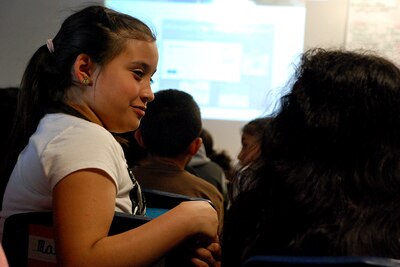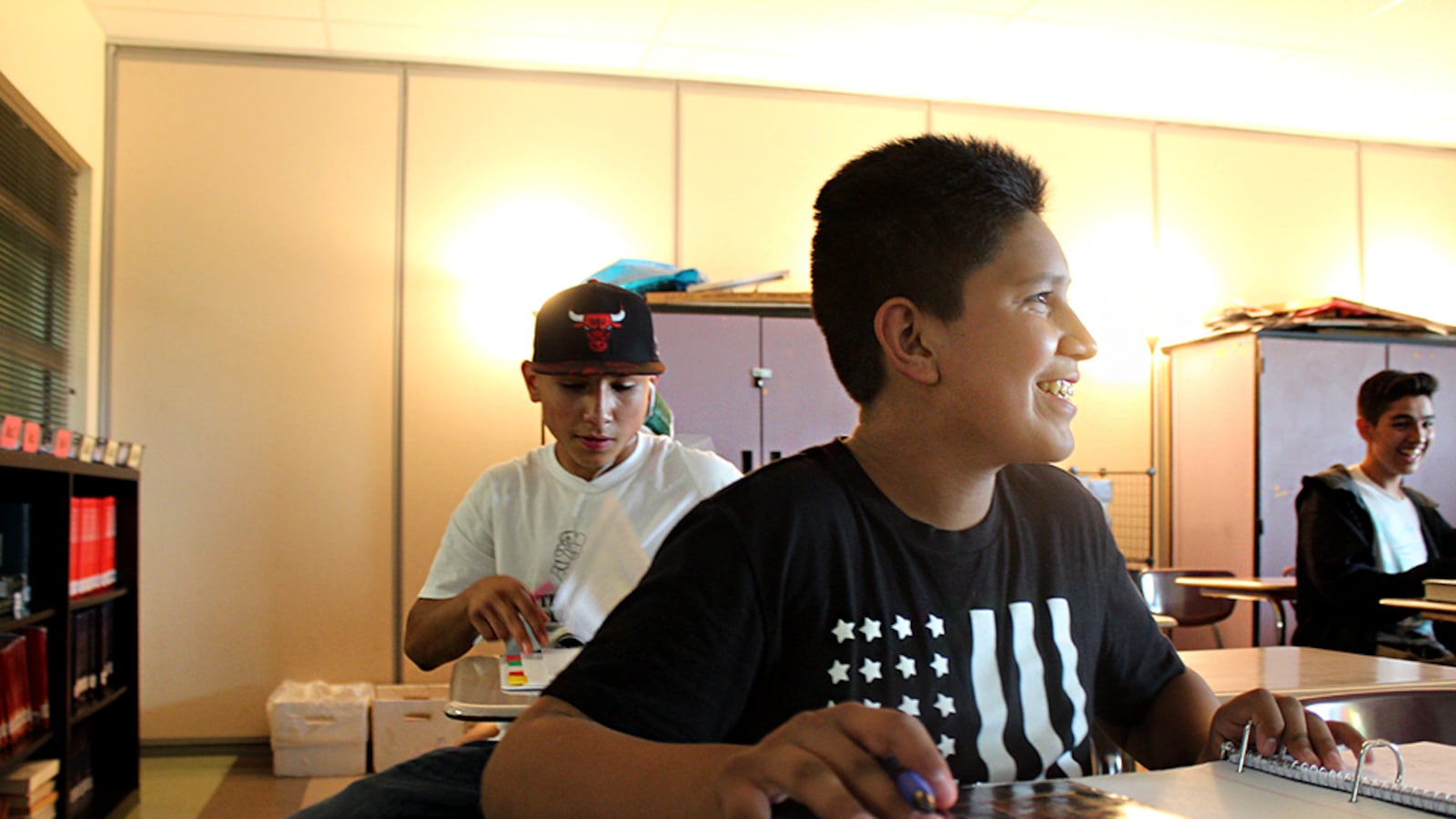LONGMONT — Cuauhtemoc Jesus Sanchez isn’t shy about why he’s enrolled in what might be one of the state’s most ambitious science, engineering, math and technology programs.
Money.
“I want to buy a house for my mom,” said the freshman at Skyline High School in Longmont, about 40 minutes north of Denver.
Sanchez is one of 50 students in the St. Vrain Valley School District to be enrolled in one of the the state’s new P-TECH programs. A similar effort also launched at Northglenn High School in Adams County.
P-TECH is a growing national effort that brings together public schools, community colleges and tech companies in an effort to provide traditionally underserved students a more robust education in science, technology, engineering and math, or STEM, and the promise of a good job.
The program is a natural fit for the St. Vrain Valley district, which for nearly a decade has devoted energy to STEM offerings with the aid of millions in federal tax dollars. Now, it is focusing more effort on serving its growing population of at-risk students — with P-TECH being one example.
“It’s going to be hard, but we’ll get through it,” said Marina Rivas, one of Sanchez’s classmates. “We’re very lucky kids.”
“We defined STEM”
In 2007, St. Vrain officials were looking for a way to keep Skyline’s mostly poor and Latino students in school. The four-year on-time graduation rate was just 77.4 percent, much lower than the district’s other high schools.
STEM in Colorado | A Chalkbeat special report
PART 1: Little access to STEM education
PART 2: St. Vrain goes all in on STEM
PART 3: What the heck is STEM?
PART 4: A scrappy STEM school with something to prove
FIRST PERSON: How my STEM education is going to help me get clean drinking water in Ethiopia
HOW I TEACH STEM: An award-winning science teacher shares her classroom practices.
HOW I TEACH STEM: An award winning fourth-grade teacher shares her classroom practices.
The Gay & Lesbian Fund for Colorado provided financial support for this series.
Patty Quinones, then principal of Skyline, went online and learned everything she could about this new trend in public schools: STEM.
STEM evangelizers then and now believe the model, which calls for more critical thinking and application than memorization and bubble tests, keeps students engaged and in school.
Quinones and her team of teachers and administrators contacted the University of Colorado’s School of Engineering and local industry officials to create what is now the STEM Academy at Skyline.
A $3.6 million federal grant, part of the Obama administration’s stimulus package following the Great Recession, paid for teacher training and technology upgrades at Skyline.
Students enroll as freshman and take four years of STEM courses that include explorations of structural engineering, renewable energy and robotics. Those who successfully complete the program — which includes a senior-year project that must be presented in front of a panel of industry experts — could lead to guaranteed admission to CU’s School of Engineering.
All district STEM offerings share the same philosophies: that learning is personalized for each student, and that students demonstrate their learning by creating products using a formal process.
“Teachers said they didn’t want to buy anything off the shelf,” Quinones said. “We defined STEM for ourselves.”
"When you get older, you’re going to have to code. … Like, if you want to build a robot to clean your room."
Camila Carmona-Zavala, Indian Peaks student
The results so far have been mixed.
Nearly 10 years after STEM Academy’s founding, Skyline officials point to a four-year graduation rate that has jumped four points to 81.4 percent.
But the school, which serves more students of color than any other high school in the district, still has challenges. White students are enrolling in the Academy at a higher rate than Latino students, and the school’s math and science ACT scores have been flat since 2010.
Current Principal Heidi Ringer said she believes an expansion of STEM programs, especially at the elementary and middle school levels, will help turn the tide.
Expansion
It’s a regular afternoon in Lila Kennelly’s second-grade class at Indian Peaks Elementary School. Students are working on a variety of computer-based projects, including using an online tool to design applications.

Camila Carmona-Zavala is struggling to get beyond the blank screen in front of her. But she knows why this work is important.
“When you get older, you’re going to have to code,” she said. “… Like, if you want to build a robot to clean your room.”
Since the creation of the STEM Academy, other STEM courses and opportunities have quickly spread to other schools in St. Vrain. Today, students at Longmont High are studying medical and bioscience. And Erie High has an engineering and aerospace program.
But the largest expansion of STEM in St. Vrain came in 2012, when the district won a $16 million federal grant to redesign many of its elementary schools — especially those that are in the same neighborhood as Skyline High and serve mostly Hispanic students from low-income homes.
As part of the redesign, each school hired a STEM coordinator to help teachers plan lessons and projects that demand students use knowledge in multiple subject areas. STEM is not isolated in a science block or math block, but talked about throughout the day.
“I think the change in the building itself is seeing students think differently,” Kennelly said. “It’s every subject all the time — which is the real world.”
Kennelly, a 30-year veteran, said the shift for both students and teachers has been difficult but rewarding. While the district has provided formal training as part of the transition, she regularly attends more casual meetings of teachers and STEM coordinators at a local brewery where teachers exchange tips about coding and robotics.
“For me, it’s been exhilarating,” she said. “I want to live in a world where every kid has an opportunity for a STEM education.”
P-TECH and beyond
It’s too soon to tell whether the changes at St. Vrain’s elementary and middle schools have made a difference academically for students. A change in state assessments also complicated matters, making comparisons difficult. But the district is all-in on STEM.
"Our picture-perfect is that in five years, 100 percent of these students will have an associates degree and be employed."
Eric Bergen, IBM program manager for P-TECH
“Now that we have this big machine going, you’ll see better and better results,” said Patty Quinones, director of innovation for St. Vrain. “It’s gonna bust wide open in a couple of years.”
And district leaders believe the new P-TECH school at Skyline is just the first of many.
“We have huge numbers begging (for the program) at other schools,” said Regina Renaldi, an assistant superintendent.
But the district isn’t in a rush. Officials want to make sure that the program is successful.
Problems with the P-TECH model have arisen. One of the first P-TECH schools in New York City has been dogged by low college completion rates and infighting among the various partners that make up the program.
“Our picture-perfect is that in five years, 100 percent of these students will have an associates degree and be employed,” said Eric Berngen, a program manager for IBM who spends three days a week at Skyline.
District leaders hope they’ll be able to offer students more certifications and apprenticeships in the coming years. St. Vrain students can already earn an Apple certification to repair iPhones and laptop computers.
“We’re no longer satisfied with just graduating students,” Renaldi said.
As for Sanchez, he’s steeling himself for the next five years, the average time it takes a student to complete the P-TECH program.
“It’s going to be kinda hard,” he said. “We’re in college and we’re barely high school students.”
Correction: An earlier version incorrectly reported the name of Skyline High School.

